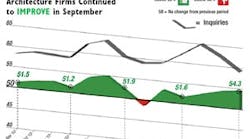Finally, some good news to end the year: At the time of this article's deadline, the American Institute of Architects' (AIA) Billings Index (ABI) had spiked at its second highest level of the year, and it continues to show signs of acceleration, suggesting a healthy demand for design-related services.
In comparison to our mid-year industry report ("The State of the Industry," May 2013) which revealed positive (albeit cautiously optimistic) economic indicators, billings have steadily increased each month since the beginning of summer. "Inquiries into new work continue to rise, despite having dipped slightly from their most recent high earlier this year, and the value of new design contracts increased in September as well," writes Jennifer Riskus, manager of economic research at AIA, in the latest ABI report. In September, the ABI reached 54.3, up from 53.8 in August. (Any score above 50 indicates an increase in billings.)
The most recent data from the American Society of Interior Designers' (ASID) quarterly Interior Design Billings Index also suggests a positive trend in economic activity for the A&D industry. The second quarter of 2013 remained positive, having closed in June at 56.4, up nearly three points from May's score of 53.7.
The momentum realized in 2012 "should carry forward, albeit at a soft pace," says Jack Kleinhenz, chief economist for ASID. He predicts that "the pace of growth is expected to lift to about 2.2 percent in the second half of 2013."
Interestingly, the AIA suggests the pragmatic response by design and architecture firms to the downturn may have been the impetus for the current upsurge in activity in the industry.
"The prolonged economic downturn that has affected the design and construction industry has actually resulted in the increased productivity levels as reported by architecture firms," says AIA Chief Economist Kermit Baker, Hon. AIA, PhD. "In addition to new approaches to business challenges, a very competitive marketplace, the utilization of new technologies and a renewed focus on efficiency have architecture firms realizing all-time highs in workplace productivity, and these new efficiencies can greatly benefit clients from a project timeline and budget standpoint."
Overall, the residential construction market outpaced nonresidential, but the outlook for commercial real estate is positive for the most part, thanks to declining vacancy rates and rising rents. While the employment outlook has been mostly stagnant, according to the AIA construction payrolls added 20,000 new jobs in September, and the demand for architectural services has also been trending upward as of August (the most recent data available). The Institute notes that this is the highest architectural payrolls have been since the spring.
Top-performing markets in the ASID Billings Index include hospitality (60.3), multi-family housing (59) and single-family (57.3). Healthcare remained unchanged (50), while declines were seen in the office (49.7), government (42.7), retail (45) and education (33.3) markets. Regional averages were all positive, with the Northeast and West performing the best at 57.7 and 57.9, respectively, and the Midwest not far behind at 56.6. The South was the lowest performing region in the second quarter, with an average of 51.4.
2014 forecast
Looking ahead, economic indicators suggest that 2014 will be another year of growth for the construction industry. The AIA Consensus Forecast, which computes the average projections from McGraw-Hill, IHS-Global Insight, FMI, Reed Construction Data, Associated Builders and Contractors, and Wells Fargo Securities, shows that the nonresidential sector is doing 5.3 percent better than earlier projections, and is up 7.6 percent from 2012 levels.
"We see 2014 as another year of measured expansion for the construction industry," says Robert Murray, McGraw-Hill Construction's vice president of economic affairs. "Against the backdrop of elevated uncertainty and federal spending cutbacks, the construction industry should still benefit from several positive factors going into 2014. Job growth, while sluggish, is still taking place. Interest rates remain very low by historical standards, and in the near term the Federal Reserve is likely to take the necessary steps to keep them low."
McGraw-Hill's 2014 Dodge Construction Outlook predicts that total U.S. construction starts for 2014 will rise 9 percent to $555.3 billion—higher than the 5 percent increase to $508 billion estimated for 2013. The report also makes the following predictions in several categories of nonresidential construction:
- Commercial building will increase 17 percent, a slightly faster pace than the 15 percent gain estimated for 2013. Both warehouses and hotels will continue to lead the way, while stores and office buildings pick up the pace. Positives for the commercial building sector include improving market fundamentals and more bank lending for commercial development, although next year's activity in dollar terms will still be 28 percent below the 2007 peak.
- Institutional building will edge up 2 percent, turning the corner after five years of decline. In the education category, colleges are revisiting capital expansion plans and the recent passage of construction bond measures in several states should help K-12 construction projects. Healthcare construction is expected to remain flat, given the continued emphasis on cost containment.
- Public works construction will drop 5 percent, pulling back after a 3 percent gain in 2013 that was driven by the start of several large highway and bridge projects. More focus on deficit reduction will limit federal support for public works, although the improved fiscal position of state and local governments will help to cushion the extent of the sector's decline.
Although forecasts such as these aren't infallible, one can sense the economic uncertainty of the Great Recession is nearly over. The A&D community can (finally) ring in a new year with well-founded expectations of growth and prosperity.



